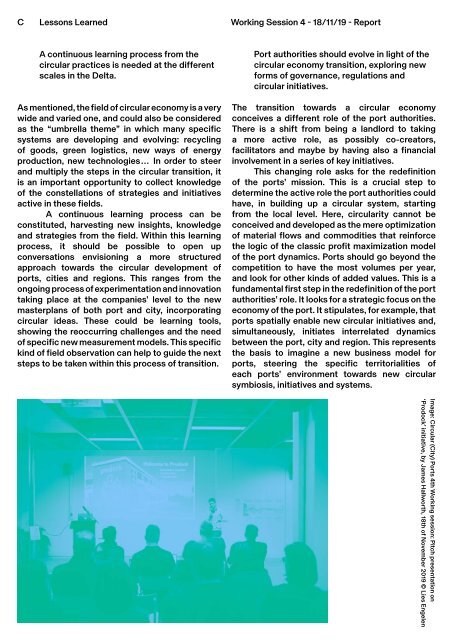CIrcular (City)Ports_ report WS4_
- No tags were found...
You also want an ePaper? Increase the reach of your titles
YUMPU automatically turns print PDFs into web optimized ePapers that Google loves.
C Lessons Learned Working Session 4 - 18/11/19 - Report<br />
A continuous learning process from the<br />
circular practices is needed at the different<br />
scales in the Delta.<br />
As mentioned, the field of circular economy is a very<br />
wide and varied one, and could also be considered<br />
as the “umbrella theme” in which many specific<br />
systems are developing and evolving: recycling<br />
of goods, green logistics, new ways of energy<br />
production, new technologies… In order to steer<br />
and multiply the steps in the circular transition, it<br />
is an important opportunity to collect knowledge<br />
of the constellations of strategies and initiatives<br />
active in these fields.<br />
A continuous learning process can be<br />
constituted, harvesting new insights, knowledge<br />
and strategies from the field. Within this learning<br />
process, it should be possible to open up<br />
conversations envisioning a more structured<br />
approach towards the circular development of<br />
ports, cities and regions. This ranges from the<br />
ongoing process of experimentation and innovation<br />
taking place at the companies’ level to the new<br />
masterplans of both port and city, incorporating<br />
circular ideas. These could be learning tools,<br />
showing the reoccurring challenges and the need<br />
of specific new measurement models. This specific<br />
kind of field observation can help to guide the next<br />
steps to be taken within this process of transition.<br />
Port authorities should evolve in light of the<br />
circular economy transition, exploring new<br />
forms of governance, regulations and<br />
circular initiatives.<br />
The transition towards a circular economy<br />
conceives a different role of the port authorities.<br />
There is a shift from being a landlord to taking<br />
a more active role, as possibly co-creators,<br />
facilitators and maybe by having also a financial<br />
involvement in a series of key initiatives.<br />
This changing role asks for the redefinition<br />
of the ports’ mission. This is a crucial step to<br />
determine the active role the port authorities could<br />
have, in building up a circular system, starting<br />
from the local level. Here, circularity cannot be<br />
conceived and developed as the mere optimization<br />
of material flows and commodities that reinforce<br />
the logic of the classic profit maximization model<br />
of the port dynamics. <strong>Ports</strong> should go beyond the<br />
competition to have the most volumes per year,<br />
and look for other kinds of added values. This is a<br />
fundamental first step in the redefinition of the port<br />
authorities’ role. It looks for a strategic focus on the<br />
economy of the port. It stipulates, for example, that<br />
ports spatially enable new circular initiatives and,<br />
simultaneously, initiates interrelated dynamics<br />
between the port, city and region. This represents<br />
the basis to imagine a new business model for<br />
ports, steering the specific territorialities of<br />
each ports’ environment towards new circular<br />
symbiosis, initiatives and systems.<br />
Image: Circular (<strong>City</strong>) <strong>Ports</strong> 4th Working session: Pitch presentation on<br />
‘Prodock’ initiative, by James Hallworth, 18th of November 2019 © Lies Engelen


















